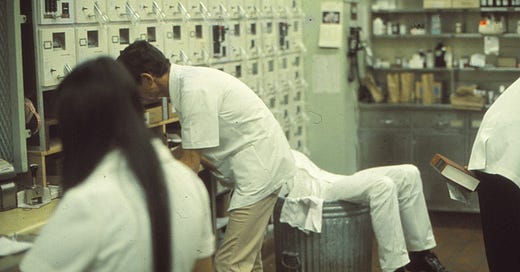by Paul Berge
As unelected cocounsels, Elong Musk and … that other billionaire whose name I can’t spell let alone pronounce, prepare to revamp federal government to their own likenesses by cutting whatever they don’t like, such as taxes, and keeping the rest for themselves, I’m reminded of a simpler time a half-century ago when I sold the US Army something that it desperately needed but already possessed.
(Memory music transition: Santana’s Oye Como Va)
The year was 1973.
It still is the year. Years don’t change simply because we leave them; 1973 retains its yearly identity despite our lack of connection. We blithely skip from one to the next, stoking the illusion that time marches on, leaving expended dates in its bloody wake. It doesn’t. In fact, time doesn’t exist. Years, such as 1973, are metaphorical steppingstones across our ego’s muzzy[1] pond, a way to catalogue over-priced wine, dead presidents, and car models.
Note: every car built in 1973 was fugly and best forgotten.
In April 1973 I’d completed AIT (Advanced Individual Training) as an Army Pharmacy Specialist (MOS 91Q) at Fort Sam Houston, TX and, as a mosquito-winged E-2 private, reported to Silas B. Hays Army Hospital at Fort Ord, CA. Being nineteen, I had no idea who Houston, Ord, or Hays were. And didn’t care. Again, I was nineteen and concerned about two things: Girls and beer, especially girls over twenty-one who could purchase beer off-post.
The pharmacy specialist’s job mimicked a registered pharmacist’s duties – mix IVs, inventory narcotics, compound and fill prescriptions, sample product -- but never dispense drugs to the patient. That required a registered pharmacist at the OUT window, a rule that would bend significantly at my next duty station. More on that in a future post. Maybe.
Fort Ord’s hospital out-patient pharmacy dispensed hundreds of prescriptions daily with pharmacists working along an assembly line. A patient would present a paper prescription (aka a script) at the IN window, where a specialist (me) would stamp it with a number. Ker-Chunk! The prescription moved down the assembly line with Henry Ford efficiency as it was filled and progressed to the OUT window where a registered pharmacist, either Army or civilian, checked and dispensed it with professional instructions regarding consumption, application, or insertion and possible side effects. To facilitate the smooth flow a sign in the waiting room digitally announced, for example: Prescriptions through 135 now ready. If you held anything under 135, you scored your drugs. Over 135, you waited. Simple. Like a Sunday morning bakery after Mass.
Eighteen months later, in 1974, the Army transferred me to Tripler Army Medical Center on Oahu, HI, a devilish assignment with another medical hero’s identity to ignore. Tripler pharmacy dispensed far more prescriptions than Fort Ord in a chaotic pace that could wear out the toughest pharmacy specialist (see photo by the author).
Adding unnecessary workload was the IN/OUT window protocol. There was none. No numbering of prescriptions, so patients only knew if their order was up when their names were shouted to the waiting room: “Sergeant Pundzak, your pizza’s ready!” Frequently, the patient lost patience and wasn’t there to hear the call and would return later to ask if it was ready, leading to wasted time looking for the order.
There was a better way, and the Army already possessed it.
By then I was a mouthy Spec-5 (E-5) and suggested that Tripler adopt the numbering system we’d used at Fort Ord. It was simple, in public domain, and worked. Therefore, my suggestion was ignored, so I filed an official DD Form 355 (as amended Jul 1959), in which I detailed the problem (clusterfuck around the pharmacy OUT window), impact (wasted labor), proposed mitigation (replicate the Hays sign), and costs (cheap). Routed through official channels, my suggestion disappeared into the yawning maw of government lethargy.
Until….
Months after I honorably left the Army in 1975 I received a congratulatory letter suitable for framing, stating that my suggestion was deemed worthy and enclosed please find a check for $38, representing one-percent of one year’s anticipated cost savings to Tripler Army Medical Center. I tossed the letter and realized that the Army’s estimated savings from my brilliant suggestion to use what it already had, was based on one hospital. There were dozens of Army pharmacies around the world, so wasn’t I entitled to a cut of the savings on each? In perpetuity?
Knowing the answer, I cashed the check, good for about ninety-five gallons of motorcycle gas. I was content, a state of being that would never glean a call from a future White House Offal Office, inviting me to trim the government’s waste and keep a small kickback for my troubles.
(Fade to black with Oye Como Va…)
[1] Cheeky allusion to my novel by the same name



